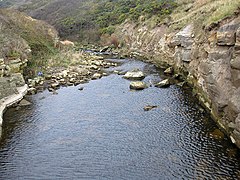Scalby Formation
| Scalby Formation | |
|---|---|
| Stratigraphic range: | |
 exposure of the Scalby Formation near Scalby, North Yorkshire | |
| Type | Geological formation |
| Unit of | Ravenscar Group |
| Sub-units | Moor Grit Member, Long Nab Member |
| Underlies | Cornbrash Formation, Osgodby Formation |
| Overlies | Scarborough Formation |
| Thickness | up to 60 metres (200 ft) |
| Lithology | |
| Primary | |
| Other |
|
| Location | |
| Region | Europe |
| Country | |
| Extent | North Yorkshire |
| Type section | |
| Named for | Scalby, North Yorkshire |
| Location | Scalby Cliff |
The Scalby Formation is a geological formation in England. Part of the Ravenscar Group, it was deposited in the Bathonian stage of the Middle Jurassic. The lower Moor Grit Member has a lithology consisting of medium to coarse grained cross bedded sandstone, with thin beds of mudstone and siltstone, while the upper Long Nab Member has a lithology consisting of predominantly laminated mudstone and siltstone, with fine to medium grained planar and cross stratified sandstones.[1]
Fossilized dinosaur tracks have been found in the Scalby Formation; these include a recently discovered footprint from a large theropod, probably a megalosaurid. The track is from the Long Nab Member, and has been assigned to the ichnogenus Megalosauripus.[2]
References[edit]
- ^ "Scalby Formation". BGS Lexicon of Named Rock Units. British Geological Survey. Retrieved 7 August 2018.
- ^ Hudson, J.G.; Romano, M.; Lomax, D.R.; Taylor, R.; Woods, M. (16 February 2023). "A new giant theropod dinosaur track from the Middle Jurassic of the Cleveland Basin, Yorkshire, UK". Proceedings of the Yorkshire Geological Society. 64 (3) – via Lyell Collection.
